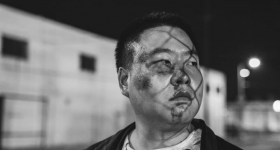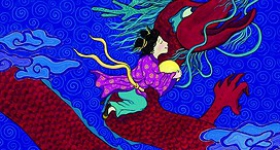In her longstanding artistic practice, Hawai’i-based artist Gaye Chan has created work across a spectrum of mediums and venues. Whether working through photography, the vegetables from her garden, political pamphlets or wire bins, her art persistently examines the politics of exchange and human interactions.
Chan first gained attention in the late 1980s with her photographs from the Angel in Folding Chair series which framed moments of affection between an Asian American lesbian couple. Over time, the focus of her work shifted from the embodied politics of relationships to conceptually driven projects, like Eating in Public, a free sharing project where Chan literally shares objects for free with various communities. Her work continues to present ways of thinking shaped by both a deep care for humanity and a fierce interrogation of the boundaries that can make it difficult to build communities.
I was fortunate to follow up on the article in Hyphen’s 25th issue to continue a discussion with Chan.
The theme of the current issue of Hyphen is “Generations.” Your artistic practice has been inspirational for subsequent generations of artists, at least in part, because of the way it has evolved over time. I first encountered your work through your early photographs and was reintroduced to your practice through the Eating in Public project years later. Can you talk a little about the shifts in your practice and interests over time?
I think there have been two important shifts in my trajectory so far. The first occurred in the late-1980s as a reaction to my swift and brief notoriety during the heat of identity politics, primarily for my series Angel on Folding Chair. At that time, my work was read almost exclusively as the unfiltered autobiography of an ‘Asian American lesbian.’ Because of this, I became extremely resistant to projects that would be read as 'personal.’
The second have been my various explorations in how to deploy my skills and sensibilities as an artist beyond the exhibition as the chief method of dissemination. Examples of this have included serving as art director of Tinfish Press, co-founding Downwind Productions, and more recently through the work of Eating in Public.
Along with your work through Eating in Public, you recently had an exhibition at the Honolulu Academy of Arts entitled Frass. The show was comprised of a series of satellite images of the United States-Mexico border that appeared to be pulled from the worm-eaten pages of an old book. The piece challenges us to look at the economic exchanges that have built a network between the two countries. Can you talk a little about that project?
My interest in using art outside of the gallery system does not mean I am hostile to exhibiting institutions. I love galleries and museums for offering a quiet space for thinking and feeling.
Frass is a part of my ongoing interest in examining cartography and photography's role in creating and maintaining the unspoken ways we understand and operate in the world. I want to unsettle the confidence we have in them as unquestioned systems. I use found imagery from Google Maps and other sources for the piece. This includes images made professionals and by amateurs that have mimicked that same visual language. I try to present them with as little manipulation as possible to allow for different ways of reading them. This openness can instill a little bit of doubt or confusion. It’s like if you were to go to your dentist but opened the door to the office found a disco, grocery store or living room. It would be confounding at first, but then you might see something you wouldn’t have noticed if you were expecting to see a disco, grocery store or living room.
What are your "inputs"? What inspires you and feeds the work?
Simple things nag at me. I obsess about how to get a lemon without going to the store. Or about what to do with all the clutter around me: scrap wood, bed frames, endless junk mail envelops, paper and plastic cups. I think much of Eating In Public’s work comes from this.
A great deal of your current work, both in your art making and educational role, seems to be centered on building artistic and political dialogues in Hawai'i. Are there unique challenges or assets to working in that local context?
The challenge of working in the local context comes if that local does not have a community that shares one's particular set of interests and temperament. This may be aesthetic, political, methodological, ethical, etc. There is a higher likelihood of finding one's affinity group in densely populated spaces. And of course if one's Local is not a center of art activities one's practice does not garner the same visibility, exposure and dialogue.
Conversely I cherish not being in a cutthroat competitive art scene.
Although you do continue exhibiting in galleries and museums, you present much of your work in "non-arts" settings. How has working as an artist in those arenas impacted your conversations with that community?
The one question that I have is: “How can a person with training and experience as a practicing artist problem-solve differently?” I love coming up with ideas that once implemented seem so obvious that they trigger a reaction of, "Oh, of course." I love the perfect fit. It’s like needing a piece of wood to wedge under a shelf and finding one exactly the right length at the Free Store we have set up through Eating In Public for people to give away unwanted things that might have use for others. It is so obvious that it is like a miracle.
Do you have any favorite stories that have come from the networks and communities built from Eating in Public?
You know how you often lose one of your socks in the laundry? When this happens my partner leaves the remaining sock on our dresser to wait for its mate to reappear. There was a sock that was on our dressers for months. It was there so long I was about to throw it out. One week later I found its mate at the Free Store. I marvel at the total strangers who made this possible. They are my community and network.









Comments